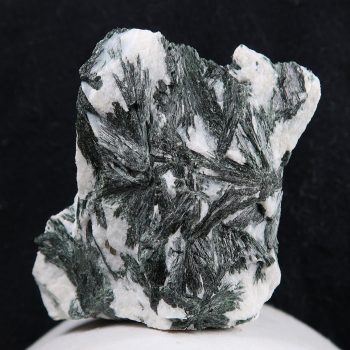Aegirine
Aegirine is a dark green mineral named after the Norse god of the sea, Ægir. It is also sometimes known as Acmite, but this is a discredited name and is typically no longer used.
Showing all 2 results
Appearance, Uses and History
Aegirine is a dark green mineral named after the Norse god of the sea, Ægir. It is also sometimes known as Acmite, but this is a discredited name and is typically no longer used.
As far as I’m aware, Aegirine does not really have any uses in industry – it is sometimes (rarely) used as a gemstone, but its main use is in mineral specimens for collectors, due to the steep, almost harsh looking crystalline formations.
Aegirine was named after the Norse god of the sea, Aegir – as the find location was close to the sea. It was originally thought to be a different species to Acmite, but now the term is used to cover both – some consider Acmite to be a fibrous green variety though.
Locales
Aegirine can be found around the world, in Brazil, Canada, Greenland, Kenya, Malawi, Norway, Nigeria, Russia, Scotland, and the USA.
Some of the best specimens come from Mt Malosa, Malawi, and are often good quality Aegirine crystals on a feldspar matrix. Other exceptional locales include Mont St Hilaire and Varennes, both in Quebec, Canada.
Mineralogy
Hazards and Warnings
Almost all rocks, minerals (and, frankly, almost all other substances on earth) can produce toxic dust when cutting, which can cause serious respiratory conditions including silicosis.
When cutting or polishing rocks, minerals, shells, etc, all work should be done wet to minimise the dust, and a suitable respirator or extraction system should be used.
Translations
Arabic:
- ايجيرين
Hindi:
Portuguese:
Bengali:
- এজিরিন
Indonesian:
Punjabi:
English:
- aegirine
- acmite
Italian:
Russian:
- эгирин
French:
Japanese:
- エジリン輝石
Spanish:
- Aegirina
German:
- Ägirin
- Aegirin
Korean:
Thai:
Gujurati:
Mandarin and Traditional Chinese:
Urdu:


